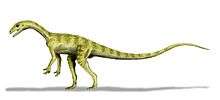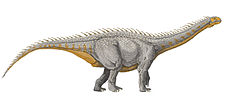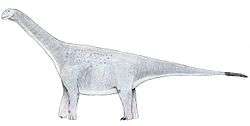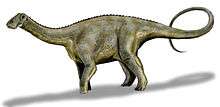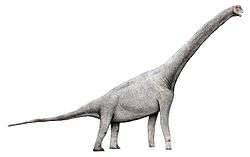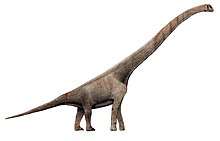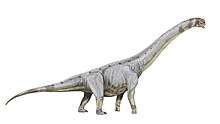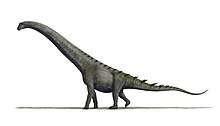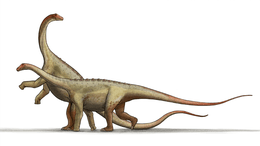Diplodocus
Diplodocus (/dɪˈplɒdəkəs/,[3][4] /daɪˈplɒdəkəs/,[4] or /ˌdɪploʊˈdoʊkəs/[3]) is a genus of diplodocid sauropod dinosaurs whose fossils were first discovered in 1877 by S. W. Williston. The generic name, coined by Othniel Charles Marsh in 1878, is a neo-Latin term derived from Greek διπλός (diplos) "double" and δοκός (dokos) "beam",[3][5] in reference to the double-beamed chevron bones located in the underside of the tail, which were then considered unique.
| Diplodocus | |
|---|---|
 | |
| Mounted D. carnegii (or "Dippy") skeleton at the Carnegie Museum of Natural History; considered to be the most famous single dinosaur skeleton in the world.[1][2] | |
| Scientific classification | |
| Kingdom: | Animalia |
| Phylum: | Chordata |
| Clade: | Dinosauria |
| Clade: | Saurischia |
| Suborder: | †Sauropodomorpha |
| Clade: | †Sauropoda |
| Family: | †Diplodocidae |
| Subfamily: | †Diplodocinae |
| Genus: | †Diplodocus Marsh, 1878 |
| Type species | |
| †Diplodocus longus (nomen dubium) Marsh, 1878 | |
| Other species | |
| Synonyms | |
| |
This genus of dinosaurs lived in what is now mid-western North America at the end of the Jurassic period. Diplodocus is one of the more common dinosaur fossils found in the middle to upper Morrison Formation, between about 154 and 152 million years ago, during the late Kimmeridgian age.[6] The Morrison Formation records an environment and time dominated by gigantic sauropod dinosaurs, such as Apatosaurus, Barosaurus, Brachiosaurus, Brontosaurus, and Camarasaurus.[7] Its great size may have been a deterrent to the predators Allosaurus and Ceratosaurus: their remains have been found in the same strata, which suggests that they coexisted with Diplodocus.
Diplodocus is among the most easily identifiable dinosaurs, with its typical sauropod shape, long neck and tail, and four sturdy legs. For many years, it was the longest dinosaur known.
Description

Among the best-known sauropods, Diplodocus were very large, long-necked, quadrupedal animals, with long, whip-like tails. Their forelimbs were slightly shorter than their hind limbs, resulting in a largely horizontal posture. The skeletal structure of these long-necked, long-tailed animals supported by four sturdy legs have been compared with suspension bridges.[8] In fact, Diplodocus carnegii is currently one of the longest dinosaurs known from a complete skeleton,[8] with a total length of 24 meters (79 ft).[9] Modern mass estimates for Diplodocus carnegii have tended to be in the 11–14.8-metric-ton (12.1–16.3-short-ton) range.[9][10][11]
Diplodocus hallorum, known from partial remains, was even larger, and is estimated to have been the size of four elephants.[12] When first described in 1991, discoverer David Gillette calculated it may have been up to 52 m (171 ft) long,[13] making it the longest known dinosaur (excluding those known from exceedingly poor remains, such as Amphicoelias). Some weight estimates of this time ranged as high as 113 metric tons (125 short tons). The estimated length was later revised downward to 33–33.5 m (108–110 ft) and later on to 32 m (105 ft)[14][15][9][16] based on findings that show that Gillette had originally misplaced vertebrae 12–19 as vertebrae 20–27. The nearly complete Diplodocus carnegii skeleton at the Carnegie Museum of Natural History in Pittsburgh, Pennsylvania, on which size estimates of D. hallorum are mainly based, also was found to have had its 13th tail vertebra come from another dinosaur, throwing off size estimates for D. hallorum even further. While dinosaurs such as Supersaurus were probably longer, fossil remains of these animals are only fragmentary.[17]
Diplodocus had an extremely long tail, composed of about 80 caudal vertebrae,[18] which are almost double the number some of the earlier sauropods had in their tails (such as Shunosaurus with 43), and far more than contemporaneous macronarians had (such as Camarasaurus with 53). Some speculation exists as to whether it may have had a defensive[19] or noisemaking (by cracking it like a coachwhip) function.[20] The tail may have served as a counterbalance for the neck. The middle part of the tail had "double beams" (oddly shaped chevron bones on the underside, which gave Diplodocus its name). They may have provided support for the vertebrae, or perhaps prevented the blood vessels from being crushed if the animal's heavy tail pressed against the ground. These "double beams" are also seen in some related dinosaurs. Chevron bones of this particular form were initially believed to be unique to Diplodocus; since then they have been discovered in other members of the diplodocid family as well as in non-diplodocid sauropods, such as Mamenchisaurus.[21]
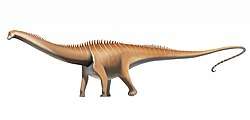
Like other sauropods, the manus (front "feet") of Diplodocus were highly modified, with the finger and hand bones arranged into a vertical column, horseshoe-shaped in cross section. Diplodocus lacked claws on all but one digit of the front limb, and this claw was unusually large relative to other sauropods, flattened from side to side, and detached from the bones of the hand. The function of this unusually specialized claw is unknown.[22]
No skull has ever been found that can be confidently said to belong to Diplodocus, though skulls of other diplodocids closely related to Diplodocus (such as Galeamopus) are well known. The skulls of diplodocids were very small compared with the size of these animals. Diplodocus had small, 'peg'-like teeth that pointed forward and were only present in the anterior sections of the jaws.[23] Its braincase was small. The neck was composed of at least 15 vertebrae and may have been held parallel to the ground and unable to be elevated much past horizontal.[24]
The discovery of partial diplodocid skin impressions in 1990 showed that some species had narrow, pointed keratinous spines, much like those on an iguana and up to 18 centimeters (7.1 in) long, on the "whiplash" portion of their tails, and possibly along the back and neck as well, as in hadrosaurids.[25][26] The spines have been incorporated into many recent reconstructions of Diplodocus, notably Walking with Dinosaurs.[27] The original description of the spines noted that the specimens in the Howe Quarry near Shell, Wyoming were associated with skeletal remains of an undescribed diplodocids "resembling Diplodocus and Barosaurus."[25] Specimens from this quarry have since been referred to Kaatedocus siberi and Barosaurus sp., rather than Diplodocus.[6][28]
Discovery and species

Several species of Diplodocus were described between 1878 and 1924. The first skeleton was found at Cañon City, Colorado, by Benjamin Mudge and Samuel Wendell Williston in 1877, and was named Diplodocus longus ('long double-beam') by paleontologist Othniel Charles Marsh in 1878.[29] Although not the type species, D. carnegii is the most completely known and most famous species due to the large number of casts of its skeleton in museums around the world.[21] Diplodocus remains have since been found in the Morrison Formation of the western U.S. states of Colorado, Utah, Montana, and Wyoming. Fossils of this animal are common, except for the skull, which has never been found with otherwise complete skeletons. D. hayi, known from a partial skeleton and skull discovered by William H. Utterback in 1902 near Sheridan, Wyoming, was described in 1924.[30] In 2015, it was renamed as the separate genus Galeamopus, and several other Diplodocus specimens were referred to that genus, leaving no definite Diplodocus skulls known.[6]
The two Morrison Formation sauropod genera Diplodocus and Barosaurus had very similar limb bones. In the past, many isolated limb bones were automatically attributed to Diplodocus, but may, in fact, have belonged to Barosaurus.[31] Fossil remains of Diplodocus have been recovered from stratigraphic zone 5 of the Morrison Formation.[32]
Valid species

- D. carnegii (also spelled D. carnegiei), named after Andrew Carnegie, is the best known, mainly due to a near-complete skeleton (specimen CM 84) collected by Jacob Wortman, of the Carnegie Museum of Natural History in Pittsburgh, Pennsylvania and described and named by John Bell Hatcher in 1901.[33] This was reconsidered as type-species for Diplodocus.[34]
- D. hallorum, first described in 1991 by Gillette as Seismosaurus halli from a partial skeleton comprising vertebrae, pelvis and ribs, specimen NMMNH P-3690, was found in 1979.[35] As the specific name honours two people, Jim and Ruth Hall, George Olshevsky later suggested to emend the name as S. hallorum, using the mandatory genitive plural; Gillette then emended the name,[13] which usage has been followed by others, including Carpenter (2006).[14] In 2004, a presentation at the annual conference of the Geological Society of America made a case for Seismosaurus being a junior synonym of Diplodocus.[36] This was followed by a much more detailed publication in 2006, which not only renamed the species Diplodocus hallorum, but also speculated that it could prove to be the same as D. longus.[37] The position that D. hallorum should be regarded as a specimen of D. longus was also taken by the authors of a redescription of Supersaurus, refuting a previous hypothesis that Seismosaurus and Supersaurus were the same.[38] A 2015 analysis of diplodocid relationships noted that these opinions are based on the more complete referred specimens of D. longus. The authors of this analysis concluded that those specimens were indeed the same species as D. hallorum, but that D. longus itself was a nomen dubium.[6]
Nomina dubia (doubtful species)
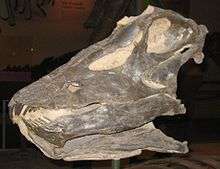
- D. longus, the type species, is known from two complete and several fragmentary caudal vertebrae from the Morrison Formation (Felch Quarry) of Colorado. Though several more complete specimens have been attributed to D. longus,[39] detailed analysis has suggested that the original fossil lacks the necessary features to allow comparison with other specimens. For this reason, it has been considered a nomen dubium, which is not an ideal situation for the type species of a well-known genus like Diplodocus. A petition to the International Commission on Zoological Nomenclature was being considered which proposed to make D. carnegii the new type species.[6][34] This proposal was rejected by the ICZN and D. longus has been maintained as the type species.[40]
- D. lacustris ("of the lake") is a nomen dubium, named by Marsh in 1884 based on specimen YPM 1922 found by Arthur Lakes, consisting of the snout and upper jaw of a smaller animal from Morrison, Colorado.[41] These remains are now believed to have been from an immature animal, rather than from a separate species.[42] In 2015, it was concluded that the specimen actually belonged to Camarasaurus.[6]
Classification
Diplodocus is both the type genus of, and gives its name to, the Diplodocidae, the family to which it belongs.[41] Members of this family, while still massive, are of a markedly more slender build than other sauropods, such as the titanosaurs and brachiosaurs. All are characterised by long necks and tails and a horizontal posture, with fore limbs shorter than hind limbs. Diplodocids flourished in the Late Jurassic of North America and possibly Africa.[18]
A subfamily, the Diplodocinae, was erected to include Diplodocus and its closest relatives, including Barosaurus. More distantly related is the contemporaneous Apatosaurus, which is still considered a diplodocid, although not a diplodocine, as it is a member of the sister subfamily Apatosaurinae.[43][44] The Portuguese Dinheirosaurus and the African Tornieria have also been identified as close relatives of Diplodocus by some authors.[45][46] The Diplodocoidea comprise the diplodocids, as well as dicraeosaurids, rebbachisaurids, Suuwassea,[43][44] Amphicoelias[46] and possibly Haplocanthosaurus,[47] and/or the nemegtosaurids.[48] This clade is the sister group to Macronaria (camarasaurids, brachiosaurids and titanosaurians).[47][48]
Cladogram of the Diplodocidae after Tschopp, Mateus, and Benson (2015) below:[6]
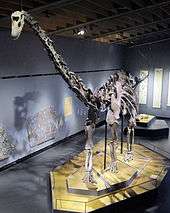
| Diplodocidae |
| |||||||||||||||||||||||||||||||||||||||||||||||||||||||||||||||||||||||||||||||||||||||||||||||||||
Paleobiology

Due to a wealth of skeletal remains, Diplodocus is one of the best-studied dinosaurs. Many aspects of its lifestyle have been subjects of various theories over the years.[21] Comparisons between the scleral rings of diplodocines and modern birds and reptiles suggest that they may have been cathemeral, active throughout the day at short intervals.[49]
Marsh and then Hatcher[50] assumed that the animal was aquatic, because of the position of its nasal openings at the apex of the cranium. Similar aquatic behavior was commonly depicted for other large sauropods, such as Brachiosaurus and Apatosaurus. A 1951 study by Kenneth A. Kermack indicates that sauropods probably could not have breathed through their nostrils when the rest of the body was submerged, as the water pressure on the chest wall would be too great.[51] Since the 1970s, general consensus has the sauropods as firmly terrestrial animals, browsing on trees, ferns, and bushes.[52]
Scientists have debated as to how sauropods were able to breathe with their large body sizes and long necks, which would have increased the amount of dead space. They likely had an avian respiratory system, which is more efficient than a mammalian and reptilian system. Reconstructions of the neck and thorax of Diplodocus show great pneumaticity, which could have played a role in respiration as it does in birds.[53]
Posture
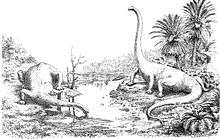
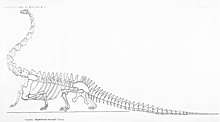
The depiction of Diplodocus posture has changed considerably over the years. For instance, a classic 1910 reconstruction by Oliver P. Hay depicts two Diplodocus with splayed lizard-like limbs on the banks of a river. Hay argued that Diplodocus had a sprawling, lizard-like gait with widely splayed legs,[55] and was supported by Gustav Tornier. This hypothesis was contested by William Jacob Holland, who demonstrated that a sprawling Diplodocus would have needed a trench through which to pull its belly.[56] Finds of sauropod footprints in the 1930s eventually put Hay's theory to rest.[52]
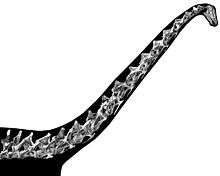
Later, diplodocids were often portrayed with their necks held high up in the air, allowing them to graze from tall trees. Studies looking at the morphology of sauropod necks have concluded that the neutral posture of Diplodocus neck was close to horizontal, rather than vertical, and scientists such as Kent Stevens have used this to argue that sauropods including Diplodocus did not raise their heads much above shoulder level.[57][58] A nuchal ligament may have held the neck in this position.[57] A 2009 study found that all tetrapods appear to hold the base of their necks at the maximum possible vertical extension when in a normal, alert posture, and argued that the same would hold true for sauropods barring any unknown, unique characteristics that set the soft tissue anatomy of their necks apart from other animals. The study found faults with Stevens' assumptions regarding the potential range of motion in sauropod necks, and based on comparing skeletons to living animals the study also argued that soft tissues could have increased flexibility more than the bones alone suggest. For these reasons they argued that Diplodocus would have held its neck at a more elevated angle than previous studies have concluded.[59]
As with the related genus Barosaurus, the very long neck of Diplodocus is the source of much controversy among scientists. A 1992 Columbia University study of diplodocid neck structure indicated that the longest necks would have required a 1.6-ton heart – a tenth of the animal's body weight. The study proposed that animals like these would have had rudimentary auxiliary "hearts" in their necks, whose only purpose was to pump blood up to the next "heart".[8] Some argue that the near-horizontal posture of the head and neck would have eliminated the problem of supplying blood to the brain, as it would not be elevated.[24]
Diet and feeding
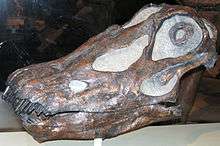
Diplodocines have highly unusual teeth compared to other sauropods. The crowns are long and slender, and elliptical in cross-section, while the apex forms a blunt, triangular point.[23] The most prominent wear facet is on the apex, though unlike all other wear patterns observed within sauropods, diplodocine wear patterns are on the labial (cheek) side of both the upper and lower teeth.[23] This implies that the feeding mechanism of Diplodocus and other diplodocids was radically different from that of other sauropods. Unilateral branch stripping is the most likely feeding behavior of Diplodocus,[60][61][62] as it explains the unusual wear patterns of the teeth (coming from tooth–food contact). In unilateral branch stripping, one tooth row would have been used to strip foliage from the stem, while the other would act as a guide and stabilizer. With the elongated preorbital (in front of the eyes) region of the skull, longer portions of stems could be stripped in a single action.[23] Also, the palinal (backwards) motion of the lower jaws could have contributed two significant roles to feeding behavior: (1) an increased gape, and (2) allowed fine adjustments of the relative positions of the tooth rows, creating a smooth stripping action.[23]
Young et al. (2012) used biomechanical modelling to examine the performance of the diplodocine skull. It was concluded that the proposal that its dentition was used for bark-stripping was not supported by the data, which showed that under that scenario, the skull and teeth would undergo extreme stresses. The hypotheses of branch-stripping and/or precision biting were both shown to be biomechanically plausible feeding behaviors.[63] Diplodocine teeth were also continually replaced throughout their lives, usually in less than 35 days, as was discovered by Michael D'Emic et al. Within each tooth socket, as many as five replacement teeth were developing to replace the next one. Studies of the teeth also reveal that it preferred different vegetation from the other sauropods of the Morrison, such as Camarasaurus. This may have better allowed the various species of sauropods to exist without competition.[64]
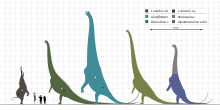
The flexibility of Diplodocus neck is debated but it should have been able to browse from low levels to about 4 m (13 ft) when on all fours.[24][57] However, studies have shown that the center of mass of Diplodocus was very close to the hip socket;[65][66] this means that Diplodocus could rear up into a bipedal posture with relatively little effort. It also had the advantage of using its large tail as a 'prop' which would allow for a very stable tripodal posture. In a tripodal posture Diplodocus could potentially increase its feeding height up to about 11 m (36 ft).[66][67]
The neck's range of movement would have also allowed the head to graze below the level of the body, leading some scientists to speculate on whether Diplodocus grazed on submerged water plants, from riverbanks. This concept of the feeding posture is supported by the relative lengths of front and hind limbs. Furthermore, its peg-like teeth may have been used for eating soft water plants.[57] Matthew Cobley et al. (2013) dispute this, finding that large muscles and cartilage would have limited neck movements. They state that the feeding ranges for sauropods like Diplodocus were smaller than previously believed and the animals may have had to move their whole bodies around to better access areas where they could browse vegetation. As such, they might have spent more time foraging to meet their minimum energy needs.[68][69] The conclusions of Cobley et al. were disputed in 2013 and 2014 by Mike Taylor, who analysed the amount and positioning of intervertebral cartilage to determine the flexibility of the neck of Diplodocus and Apatosaurus. Taylor found that the neck of Diplodocus was very flexible, and that Cobley et al. were incorrect, in that flexibility as implied by bones is less than in reality.[70]
In 2010, Whitlock et al. described a juvenile skull at the time referred to Diplodocus (CM 11255) that differed greatly from adult skulls of the same genus: its snout was not blunt, and the teeth were not confined to the front of the snout. These differences suggest that adults and juveniles were feeding differently. Such an ecological difference between adults and juveniles had not been previously observed in sauropodomorphs.[71]
Reproduction and growth
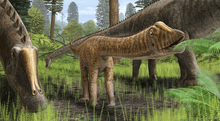
While the long neck has traditionally been interpreted as a feeding adaptation, it was also suggested[72] that the oversized neck of Diplodocus and its relatives may have been primarily a sexual display, with any other feeding benefits coming second. A 2011 study refuted this idea in detail.[73]
While no evidence indicates Diplodocus nesting habits, other sauropods, such as the titanosaurian Saltasaurus, have been associated with nesting sites.[74][75] The titanosaurian nesting sites indicate that they may have laid their eggs communally over a large area in many shallow pits, each covered with vegetation. Diplodocus may have done the same. The documentary Walking with Dinosaurs portrayed a mother Diplodocus using an ovipositor to lay eggs, but it was pure speculation on the part of the documentary author.[27] For Diplodocus and other sauropods, the size of clutches and individual eggs were surprisingly small for such large animals. This appears to have been an adaptation to predation pressures, as large eggs would require greater incubation time and thus would be at greater risk.[76]
Based on a number of bone histology studies, Diplodocus, along with other sauropods, grew at a very fast rate, reaching sexual maturity at just over a decade, and continued to grow throughout their lives.[77][78][79]
Paleoecology
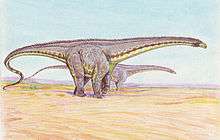
The Morrison Formation is a sequence of shallow marine and alluvial sediments which, according to radiometric dating, ranges between 156.3 million years old (Ma) at its base,[80] and 146.8 million years old at the top,[81] which places it in the late Oxfordian, Kimmeridgian, and early Tithonian stages of the Late Jurassic period. This formation is interpreted as a semiarid environment with distinct wet and dry seasons. The Morrison Basin, where dinosaurs lived, stretched from New Mexico to Alberta and Saskatchewan, and was formed when the precursors to the Front Range of the Rocky Mountains started pushing up to the west. The deposits from their east-facing drainage basins were carried by streams and rivers and deposited in swampy lowlands, lakes, river channels, and floodplains.[82] This formation is similar in age to the Lourinha Formation in Portugal and the Tendaguru Formation in Tanzania.[83]
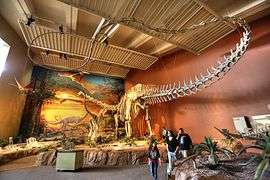
The Morrison Formation records an environment and time dominated by gigantic sauropod dinosaurs.[84] Dinosaurs known from the Morrison include the theropods Ceratosaurus, Koparion, Stokesosaurus, Ornitholestes, Allosaurus and Torvosaurus, the sauropods Apatosaurus, Brachiosaurus, Camarasaurus, and Diplodocus, and the ornithischians Camptosaurus, Dryosaurus, Othnielia, Gargoyleosaurus and Stegosaurus.[85] Diplodocus is commonly found at the same sites as Apatosaurus, Allosaurus, Camarasaurus, and Stegosaurus.[86] Allosaurus accounted for 70 to 75% of theropod specimens and was at the top trophic level of the Morrison food web.[87] Many of the dinosaurs of the Morrison Formation are the same genera as those seen in Portuguese rocks of the Lourinha Formation (mainly Allosaurus, Ceratosaurus, Torvosaurus, and Stegosaurus), or have a close counterpart (Brachiosaurus and Lusotitan, Camptosaurus and Draconyx).[83] Other vertebrates that shared this paleoenvironment included ray-finned fishes, frogs, salamanders, turtles like Dorsetochelys, sphenodonts, lizards, terrestrial and aquatic crocodylomorphans such as Hoplosuchus, and several species of pterosaur like Harpactognathus and Mesadactylus. Shells of bivalves and aquatic snails are also common. The flora of the period has been revealed by fossils of green algae, fungi, mosses, horsetails, cycads, ginkgoes, and several families of conifers. Vegetation varied from river-lining forests of tree ferns, and ferns (gallery forests), to fern savannas with occasional trees such as the Araucaria-like conifer Brachyphyllum.[88]
Cultural significance
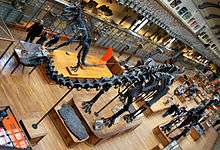

Diplodocus has been a famous and much-depicted dinosaur as it has been on display in more places than any other sauropod dinosaur.[89] Much of this has probably been due to its wealth of skeletal remains and former status as the longest dinosaur.
The donation of many mounted skeletal casts of "Dippy" by industrialist Andrew Carnegie to potentates around the world at the beginning of the 20th century[90] did much to familiarize it to people worldwide. Casts of Diplodocus skeletons are still displayed in many museums worldwide, including D. carnegii in a number of institutions.[52]
This project, along with its association with 'big science', philanthropism, and capitalism, drew much public attention in Europe. The German satirical weekly Kladderadatsch devoted a poem to the dinosaur:
... Auch ein viel älterer Herr noch muß
Den Wanderburschen spielen
Er ist genannt Diplodocus
und zählt zu den Fossilen
Herr Carnegie verpackt ihn froh
In riesengroße Archen
Und schickt als Geschenk ihn so
An mehrere Monarchen ...[91]
(Translation: ... But even a much older gent • Sees itself forced to wander • He goes by the name Diplodocus • And belongs among the fossils • Mr. Carnegie packs him joyfully • Into giant arks • And sends him as gift • To several monarchs ...) "Le diplodocus" became a generic term for sauropods in French, much as "brontosaur" is in English.[92]
D. longus is displayed the Senckenberg Museum in Frankfurt (a skeleton made up of several specimens, donated in 1907 by the American Museum of Natural History), Germany.[93][94] A mounted and more complete skeleton of D. longus is at the Smithsonian National Museum of Natural History in Washington, DC,[95] while a mounted skeleton of D. hallorum (formerly Seismosaurus), which may be the same as D. longus, can be found at the New Mexico Museum of Natural History and Science.[96]
Dance musician Diplo derived his name from the dinosaur.[97]
A war machine (landship) from WW1 named Boirault machine was designed in 1915, later deemed impractical and hence given a nickname "Diplodocus militaris".[98]
References
- Ulrich Merkl (November 25, 2015). Dinomania: The Lost Art of Winsor McCay, The Secret Origins of King Kong, and the Urge to Destroy New York. Fantagraphics Books. ISBN 978-1-60699-840-3.
Although it narrowly failed to win the race with the New York Museum of Natural History in 1905, the Diplodocus carnegii is the most famous dinosaur skeleton today, due to the large number of casts in museums around the world
- Breithaupt, Brent H, The discovery and loss of the “colossal” Brontosaurus giganteus from the fossil fields of Wyoming (USA) and the events that led to the discovery of Diplodocus carnegii: the first mounted dinosaur on the Iberian Peninsula, VI Jornadas Internacionales sobre Paleontología de Dinosaurios y su Entorno, 5-7 September 2013, p.49: "“Dippy" was and still is the most widely seen and best-known dinosaur ever found."
- Simpson, John; Edmund Weiner, eds. (1989). The Oxford English Dictionary (2nd ed.). Oxford: Oxford University Press. ISBN 978-0-19-861186-8.
- Pickett, Joseph P., ed. (2000). The American Heritage Dictionary of the English Language (4th ed.). Boston: Houghton Mifflin Company. ISBN 978-0-395-82517-4.
- "diplodocus". Online Etymology Dictionary.
- Tschopp, E.; Mateus, O. V.; Benson, R. B. J. (2015). "A specimen-level phylogenetic analysis and taxonomic revision of Diplodocidae (Dinosauria, Sauropoda)". PeerJ. 3: e857. doi:10.7717/peerj.857. PMC 4393826. PMID 25870766.
- Turner, C.E.; Peterson, F. (2004). "Reconstruction of the Upper Jurassic Morrison Formation extinct ecosystem—a synthesis". Sedimentary Geology. 167 (3–4): 309–355. Bibcode:2004SedG..167..309T. doi:10.1016/j.sedgeo.2004.01.009.
- Lambert D. (1993). The Ultimate Dinosaur Book. DK Publishing. ISBN 978-0-86438-417-1.
- Paul, Gregory S. (2016). Princeton Field Guide to Dinosaurs. Princeton University Press. ISBN 978-0-691-13720-9.
- Foster, J.R. (2003). Paleoecological Analysis of the Vertebrate Fauna of the Morrison Formation (Upper Jurassic), Rocky Mountain Region, U.S.A. New Mexico Museum of Natural History and Science:Albuquerque, New Mexico. Bulletin 23.
- Benson, R. B. J.; Campione, N. S. E.; Carrano, M. T.; Mannion, P. D.; Sullivan, C.; Upchurch, P.; Evans, D. C. (2014). "Rates of Dinosaur Body Mass Evolution Indicate 170 Million Years of Sustained Ecological Innovation on the Avian Stem Lineage". PLOS Biology. 12 (5): e1001853. doi:10.1371/journal.pbio.1001853. PMC 4011683. PMID 24802911.
- Holtz, Thomas R., Jr.; Rey, Luis V. (2011). Dinosaurs: the most complete, up-to-date encyclopedia for dinosaur lovers of all ages (Winter 2011 appendix). New York: Random House. ISBN 978-0-375-82419-7.
- Gillette, D.D., 1994, Seismosaurus: The Earth Shaker. New York, Columbia University Press, 205 pp
- Carpenter, K. (2006). "Biggest of the big: a critical re-evaluation of the mega-sauropod Amphicoelias fragillimus." In Foster, J.R. and Lucas, S.G., eds., 2006, Paleontology and Geology of the Upper Jurassic Morrison Formation. New Mexico Museum of Natural History and Science Bulletin 36: 131–138.
- Herne, Matthew C.; Lucas, Spencer G. (2006). "Seismosaurus hallorum: Osteological reconstruction from the holotype". New Mexico Museum of Natural History and Science Bulletin. 36.
- "The biggest of the big". Skeletaldrawing.com. June 14, 2013. Retrieved May 26, 2016.
- Wedel, M.J. and Cifelli, R.L. Sauroposeidon: Oklahoma's Native Giant. 2005. Oklahoma Geology Notes 65:2.
- Wilson JA (2005). "Overview of Sauropod Phylogeny and Evolution". In Rogers KA, Wilson JA (eds.). The Sauropods:Evolution and Paleobiology. Indiana University Press. pp. 15–49. ISBN 978-0-520-24623-2.
- Holland WJ (1915). "Heads and Tails: a few notes relating to the structure of sauropod dinosaurs". Annals of the Carnegie Museum. 9: 273–278.
- Myhrvold NP, Currie PJ (1997). "Supersonic sauropods? Tail dynamics in the diplodocids". Paleobiology. 23 (4): 393–409. doi:10.1017/s0094837300019801.
- Benton, Michael J. (2012). Prehistoric Life. Dorling Kindersley. pp. 268–269. ISBN 978-0-7566-9910-9.
- Bonnan, M. F. (2003). "The evolution of manus shape in sauropod dinosaurs: implications for functional morphology, forelimb orientation, and phylogeny". Journal of Vertebrate Paleontology. 23 (3): 595–613. doi:10.1671/A1108.
- Upchurch, P.; Barrett, P.M. (2000). "The evolution of sauropod feeding mechanism". In Sues, Hans Dieter (ed.). Evolution of Herbivory in Terrestrial Vertebrates. Cambridge University Press. ISBN 978-0-521-59449-3.
- Stevens, K.A.; Parrish, J.M. (1999). "Neck posture and feeding habits of two Jurassic sauropod dinosaurs". Science. 284 (5415): 798–800. Bibcode:1999Sci...284..798S. doi:10.1126/science.284.5415.798. PMID 10221910.
- Czerkas, S. A. (1993). "Discovery of dermal spines reveals a new look for sauropod dinosaurs". Geology. 20 (12): 1068–1070. Bibcode:1992Geo....20.1068C. doi:10.1130/0091-7613(1992)020<1068:dodsra>2.3.co;2.
- Czerkas, S. A. (1994). "The history and interpretation of sauropod skin impressions." In Aspects of Sauropod Paleobiology (M. G. Lockley, V. F. dos Santos, C. A. Meyer, and A. P. Hunt, Eds.), Gaia No. 10. (Lisbon, Portugal).
- Haines, T., James, J. Time of the Titans Archived October 31, 2013, at the Wayback Machine. ABC Online.
- Tschopp, E.; Mateus, O. V. (2012). "The skull and neck of a new flagellicaudatan sauropod from the Morrison Formation and its implication for the evolution and ontogeny of diplodocid dinosaurs". Journal of Systematic Palaeontology. 11 (7): 1. doi:10.1080/14772019.2012.746589. hdl:2318/1525401.
- Marsh OC (1878). "Principal characters of American Jurassic dinosaurs. Part I". American Journal of Science. 3 (95): 411–416. doi:10.2475/ajs.s3-16.95.411. hdl:2027/hvd.32044107172876.
- Holland WJ. The skull of Diplodocus. Memoirs of the Carnegie Museum IX; 379–403 (1924).
- McIntosh (2005). "The Genus Barosaurus (Marsh)". In Carpenter, Kenneth; Tidswell, Virginia (eds.). Thunder Lizards: The Sauropodomorph Dinosaurs. Indiana University Press. pp. 38–77. ISBN 978-0-253-34542-4.
- Foster, J. (2007). "Appendix." Jurassic West: The Dinosaurs of the Morrison Formation and Their World. Indiana University Press. pp. 327–329.
- Brezinski, D. K.; Kollar, A. D. (2008). "Geology of the Carnegie Museum Dinosaur Quarry Site of Diplodocus carnegii, Sheep Creek, Wyoming". Annals of Carnegie Museum. 77 (2): 243–252. doi:10.2992/0097-4463-77.2.243.
- Tschopp, E.; Mateus, O. (2016). "Diplodocus Marsh, 1878 (Dinosauria, Sauropoda): proposed designation of D. carnegii Hatcher, 1901 as the type species". Bulletin of Zoological Nomenclature. 73 (1): 17–24. doi:10.21805/bzn.v73i1.a22.
- Gillette, D.D. (1991). "Seismosaurus halli, gen. et sp. nov., a new sauropod dinosaur from the Morrison Formation (Upper Jurassic/Lower Cretaceous) of New Mexico, USA". Journal of Vertebrate Paleontology. 11 (4): 417–433. doi:10.1080/02724634.1991.10011413.
- Lucas S, Herne M, Heckert A, Hunt A, and Sullivan R. Reappraisal of Seismosaurus, A Late Jurassic Sauropod Dinosaur from New Mexico. The Geological Society of America, 2004 Denver Annual Meeting (November 7–10, 2004). Retrieved on May 24, 2007.
- Lucas, S.G.; Spielman, J.A.; Rinehart, L.A.; Heckert, A.B.; Herne, M.C.; Hunt, A.P.; Foster, J.R.; Sullivan, R.M. (2006). "Taxonomic status of Seismosaurus hallorum, a Late Jurassic sauropod dinosaur from New Mexico". In Foster, J.R.; Lucas, S.G. (eds.). Paleontology and Geology of the Upper Morrison Formation. Bulletin of the New Mexico Museum of Natural History and Science. New Mexico Museum of Natural History and Science (bulletin 36). pp. 149–161. ISSN 1524-4156.
- Lovelace, David M.; Hartman, Scott A.; Wahl, William R. (2007). "Morphology of a specimen of Supersaurus (Dinosauria, Sauropoda) from the Morrison Formation of Wyoming, and a re-evaluation of diplodocid phylogeny". Arquivos do Museu Nacional. 65 (4): 527–544.
- Upchurch P, Barrett PM, Dodson P (2004). "Sauropoda". In Weishampel DB, Dodson P, Osmólska H (eds.). The Dinosauria (2nd ed.). University of California Press. p. 305. ISBN 978-0-520-24209-8.
- ICZN. (2018). "Opinion 2425 (Case 3700) – Diplodocus Marsh, 1878 (Dinosauria, Sauropoda): Diplodocus longus Marsh, 1878 maintained as the type species". Bulletin of Zoological Nomenclature. 75 (1): 285–287. doi:10.21805/bzn.v75.a062.
- Marsh, O.C. (1884). "Principal characters of American Jurassic dinosaurs. Part VII. On the Diplodocidae, a new family of the Sauropoda". American Journal of Science. 3 (158): 160–168. Bibcode:1884AmJS...27..161M. doi:10.2475/ajs.s3-27.158.161.
- Upchurch, P.; Barrett, P.M.; Dodson, P. (2004). "Sauropoda". In D. B. Weishampel; P. Dodson; H. Osmólska (eds.). The Dinosauria (2nd edition). University of California Press. pp. 259–322. ISBN 978-0-520-25408-4.
- Taylor, M.P.; Naish, D. (2005). "The phylogenetic taxonomy of Diplodocoidea (Dinosauria: Sauropoda)". PaleoBios. 25 (2): 1–7. ISSN 0031-0298.
- Harris, J.D. (2006). "The significance of Suuwassea emiliae (Dinosauria: Sauropoda) for flagellicaudatan intrarelationships and evolution". Journal of Systematic Palaeontology. 4 (2): 185–198. doi:10.1017/S1477201906001805. S2CID 9646734.
- Bonaparte, J.F.; Mateus, O. (1999). "A new diplodocid, Dinheirosaurus lourinhanensis gen. et sp. nov., from the Late Jurassic beds of Portugal". Revista del Museo Argentino de Ciencias Naturales. 5 (2): 13–29. Archived from the original on 19 February 2012. Retrieved 13 June 2013.
- Rauhut, O.W.M.; Remes, K.; Fechner, R.; Cladera, G.; Puerta, P. (2005). "Discovery of a short-necked sauropod dinosaur from the Late Jurassic period of Patagonia". Nature. 435 (7042): 670–672. Bibcode:2005Natur.435..670R. doi:10.1038/nature03623. PMID 15931221.
- Wilson, J. A. (2002). "Sauropod dinosaur phylogeny: critique and cladistica analysis". Zoological Journal of the Linnean Society. 136 (2): 217–276. doi:10.1046/j.1096-3642.2002.00029.x.
- Upchurch P, Barrett PM, Dodson P (2004). "Sauropoda". In Weishampel DB, Dodson P, Osmólska H (eds.). The Dinosauria (2nd ed.). University of California Press. p. 316. ISBN 978-0-520-24209-8.
- Schmitz, L.; Motani, R. (2011). "Nocturnality in Dinosaurs Inferred from Scleral Ring and Orbit Morphology". Science. 332 (6030): 705–8. Bibcode:2011Sci...332..705S. doi:10.1126/science.1200043. PMID 21493820. S2CID 33253407.
- Hatcher JB. "Diplodocus (Marsh): Its osteology, taxonomy, and probable habits, with a restoration of the skeleton". Memoirs of the Carnegie Museum, vol. 1 (1901), pp. 1–63
- Kermack, Kenneth A. (1951). "A note on the habits of sauropods". Annals and Magazine of Natural History. 12 (4): 830–832. doi:10.1080/00222935108654213.
- Gangewere, J.R. (1999). "Diplodocus carnegii Archived 12 January 2012 at the Wayback Machine". Carnegie Magazine.
- Pierson, D. J. (2009). "The Physiology of Dinosaurs: Circulatory and Respiratory Function in the Largest Animals Ever to Walk the Earth". Respiratory Care. 54 (7): 887–911. doi:10.4187/002013209793800286. PMID 19558740.
- Hay, O. P., 1910, Proceedings of the Washington Academy of Sciences, vol. 12,, pp. 1–25
- Hay, Dr. Oliver P., "On the Habits and Pose of the Sauropod Dinosaurs, especially of Diplodocus." The American Naturalist, Vol. XLII, Oct. 1908
- Holland, Dr. W. J. (1910). "A Review of Some Recent Criticisms of the Restorations of Sauropod Dinosaurs Existing in the Museums of the United States, with Special Reference to that of Diplodocus carnegii in the Carnegie Museum". The American Naturalist. 44 (521): 259–283. doi:10.1086/279138.
- Stevens KA, Parrish JM (2005). "Neck Posture, Dentition and Feeding Strategies in Jurassic Sauropod Dinosaurs". In Carpenter, Kenneth, Tidswell, Virginia (eds.). Thunder Lizards: The Sauropodomorph Dinosaurs. Indiana University Press. pp. 212–232. ISBN 978-0-253-34542-4.
- Upchurch, P; et al. (2000). "Neck Posture of Sauropod Dinosaurs" (PDF). Science. 287 (5453): 547b. doi:10.1126/science.287.5453.547b. Retrieved November 28, 2006.
- Taylor, M.P.; Wedel, M.J.; Naish, D. (2009). "Head and neck posture in sauropod dinosaurs inferred from extant animals" (PDF). Acta Palaeontologica Polonica. 54 (2): 213–220. doi:10.4202/app.2009.0007.
- Norman, D.B. (1985). The illustrated Encyclopedia of Dinosaurs. London: Salamander Books Ltd
- Dodson, P. (1990). "Sauropod paleoecology". In Weishampel, D.B.; Dodson, P.; Osmólska, H. (eds.). The Dinosauria" 1st Edition. University of California Press. ASIN B008UBRHZM.
- Barrett, P.M.; Upchurch, P. (1994). "Feeding mechanisms of Diplodocus". Gaia. 10: 195–204.
- Young, Mark T.; Rayfield, Emily J.; Holliday, Casey M.; Witmer, Lawrence M.; Button, David J.; Upchurch, Paul; Barrett, Paul M. (August 2012). "Cranial biomechanics of Diplodocus (Dinosauria, Sauropoda): testing hypotheses of feeding behavior in an extinct megaherbivore". Naturwissenschaften. 99 (8): 637–643. Bibcode:2012NW.....99..637Y. doi:10.1007/s00114-012-0944-y. ISSN 1432-1904. PMID 22790834.
- D’Emic, M. D.; Whitlock, J. A.; Smith, K. M.; Fisher, D. C.; Wilson, J. A. (2013). Evans, A. R. (ed.). "Evolution of high tooth replacement rates in sauropod dinosaurs". PLOS ONE. 8 (7): e69235. Bibcode:2013PLoSO...869235D. doi:10.1371/journal.pone.0069235. PMC 3714237. PMID 23874921.
- Henderson, Donald M. (2006). "Burly gaits: centers of mass, stability, and the trackways of sauropod dinosaurs". Journal of Vertebrate Paleontology. 26 (4): 907–921. doi:10.1671/0272-4634(2006)26[907:BGCOMS]2.0.CO;2.
- Mallison, H. (2011). "Rearing Giants – kinetic-dynamic modeling of sauropod bipedal and tripodal poses". In Farlow, J.; Klein, N.; Remes, K.; Gee, C.; Snader, M. (eds.). Biology of the Sauropod Dinosaurs: Understanding the life of giants. Life of the Past. Indiana University Press. ISBN 978-0-253-35508-9.
- Paul, Gregory S. (2017). "Restoring Maximum Vertical Browsing Reach in Sauropod Dinosaurs". The Anatomical Record. 300 (10): 1802–1825. doi:10.1002/ar.23617. PMID 28556505.
- Cobley, Matthew J.; Rayfield, Emily J.; Barrett, Paul M. (2013). "Inter-Vertebral Flexibility of the Ostrich Neck: Implications for Estimating Sauropod Neck Flexibility". PLOS ONE. 8 (8): e72187. Bibcode:2013PLoSO...872187C. doi:10.1371/journal.pone.0072187. PMC 3743800. PMID 23967284.
- Ghose, Tia (August 15, 2013). "Ouch! Long-Necked Dinosaurs Had Stiff Necks". livescience.com. Retrieved January 31, 2015.
- Taylor, M.P. (2014). "Quantifying the effect of intervertebral cartilage on neutral posture in the necks of sauropod dinosaurs". PeerJ. 2: e712. doi:10.7717/peerj.712. PMC 4277489. PMID 25551027.
- Whitlock, John A.; Wilson, Jeffrey A.; Lamanna, Matthew C. (March 2010). "Description of a Nearly Complete Juvenile Skull of Diplodocus (Sauropoda: Diplodocoidea) from the Late Jurassic of North America". Journal of Vertebrate Paleontology. 30 (2): 442–457. doi:10.1080/02724631003617647.
- Senter, P. (2006). "Necks for Sex: Sexual Selection as an Explanation for Sauropod Neck Elongation". Journal of Zoology. 271 (1): 45–53. doi:10.1111/j.1469-7998.2006.00197.x.
- Taylor, M.P.; Hone, D.W.E.; Wedel, M.J.; Naish, D. (2011). "The long necks of sauropods did not evolve primarily through sexual selection" (PDF). Journal of Zoology. 285 (2): 151–160. doi:10.1111/j.1469-7998.2011.00824.x.
- Walking on Eggs: The Astonishing Discovery of Thousands of Dinosaur Eggs in the Badlands of Patagonia, by Luis Chiappe and Lowell Dingus. June 19, 2001, Scribner
- Grellet-Tinner, Chiappe Coria (2004). "Eggs of titanosaurid sauropods from the Upper Cretaceous of Auca Mahuevo (Argentina)". Canadian Journal of Earth Sciences. 41 (8): 949–960. Bibcode:2004CaJES..41..949G. doi:10.1139/e04-049.
- Ruxton, Graeme D.; Birchard, Geoffrey F.; Deeming, D Charles (2014). "Incubation time as an important influence on egg production and distribution into clutches for sauropod dinosaurs". Paleobiology. 40 (3): 323–330. doi:10.1666/13028.
- Sander, P. M. (2000). "Long bone histology of the Tendaguru sauropods: Implications for growth and biology". Paleobiology. 26 (3): 466–488. doi:10.1666/0094-8373(2000)026<0466:lhotts>2.0.co;2. JSTOR 2666121.
- Sander, P. M.; N. Klein; E. Buffetaut; G. Cuny; V. Suteethorn; J. Le Loeuff (2004). "Adaptive radiation in sauropod dinosaurs: Bone histology indicates rapid evolution of giant body size through acceleration". Organisms, Diversity & Evolution. 4 (3): 165–173. doi:10.1016/j.ode.2003.12.002.
- Sander, P. M.; N. Klein (2005). "Developmental plasticity in the life history of a prosauropod dinosaur". Science. 310 (5755): 1800–1802. Bibcode:2005Sci...310.1800S. doi:10.1126/science.1120125. PMID 16357257.
- Trujillo, K.C.; Chamberlain, K.R.; Strickland, A. (2006). "Oxfordian U/Pb ages from SHRIMP analysis for the Upper Jurassic Morrison Formation of southeastern Wyoming with implications for biostratigraphic correlations". Geological Society of America Abstracts with Programs. 38 (6): 7.
- Bilbey, S.A. (1998). "Cleveland-Lloyd Dinosaur Quarry – age, stratigraphy and depositional environments". In Carpenter, K.; Chure, D.; Kirkland, J.I. (eds.). The Morrison Formation: An Interdisciplinary Study. Modern Geology 22. Taylor and Francis Group. pp. 87–120. ISSN 0026-7775.
- Russell, Dale A. (1989). An Odyssey in Time: Dinosaurs of North America. Minocqua, Wisconsin: NorthWord Press. pp. 64–70. ISBN 978-1-55971-038-1.
- Mateus, Octávio (2006). "Jurassic dinosaurs from the Morrison Formation (USA), the Lourinhã and Alcobaça Formations (Portugal), and the Tendaguru Beds (Tanzania): A comparison". In Foster, John R.; Lucas, Spencer G. (eds.). Paleontology and Geology of the Upper Jurassic Morrison Formation. New Mexico Museum of Natural History and Science Bulletin, 36. Albuquerque, New Mexico: New Mexico Museum of Natural History and Science. pp. 223–231.
- Foster, J. (2007). "Appendix." Jurassic West: The Dinosaurs of the Morrison Formation and Their World. Indiana University Press. pp. 327–329.
- Chure, Daniel J.; Litwin, Ron; Hasiotis, Stephen T.; Evanoff, Emmett; Carpenter, Kenneth (2006). "The fauna and flora of the Morrison Formation: 2006". In Foster, John R.; Lucas, Spencer G. (eds.). Paleontology and Geology of the Upper Jurassic Morrison Formation. New Mexico Museum of Natural History and Science Bulletin, 36. Albuquerque, New Mexico: New Mexico Museum of Natural History and Science. pp. 233–248.
- Dodson, P.; Behrensmeyer, A.K.; Bakker, R.T.; McIntosh, J.S. (1980). "Taphonomy and paleoecology of the dinosaur beds of the Jurassic Morrison Formation". Paleobiology. 6 (1): 208–232. doi:10.1017/S0094837300025768. JSTOR 240035.
- Foster, John R. (2003). Paleoecological Analysis of the Vertebrate Fauna of the Morrison Formation (Upper Jurassic), Rocky Mountain Region, U.S.A. New Mexico Museum of Natural History and Science Bulletin, 23. Albuquerque, New Mexico: New Mexico Museum of Natural History and Science. p. 29.
- Carpenter, Kenneth (2006). "Biggest of the big: a critical re-evaluation of the mega-sauropod Amphicoelias fragillimus". In Foster, John R.; Lucas, Spencer G. (eds.). Paleontology and Geology of the Upper Jurassic Morrison Formation. New Mexico Museum of Natural History and Science Bulletin, 36. Albuquerque, New Mexico: New Mexico Museum of Natural History and Science. pp. 131–138.
- "Diplodocus." In: Dodson, Peter & Britt, Brooks & Carpenter, Kenneth & Forster, Catherine A. & Gillette, David D. & Norell, Mark A. & Olshevsky, George & Parrish, J. Michael & Weishampel, David B. The Age of Dinosaurs. Publications International, LTD. p. 58–59. ISBN 0-7853-0443-6.
- Rea, Tom (2001). Bone Wars. The Excavation and Celebrity of Andrew Carnegie's Dinosaur. Pittsburgh University Press. See particularly pages 1–11 and 198–216.
- "Die Wanderbursche", in: Kladderadatsch, 7 May 1908
- Russell, Dale A. (1988). An Odyssey in Time: the Dinosaurs of North America. NorthWord Press, Minocqua, WI. p. 76.
- Sachs, Sven (2001). "Diplodocus – Ein Sauropode aus dem Oberen Jura (Morrison-Formation) Nordamerikas". Natur und Museum. 131 (5): 133–150.
- Beasley, Walter (1907). "An American Dinosaur for Germany." The World Today, August 1907: 846–849.
- "Dinosaur Collections". National Museum of Natural History. 2008.
- "Age of Giants Hall Archived 1 November 2013 at the Wayback Machine". New Mexico Museum of Natural History and Science.
- "Diplo Bio, Music, News & Shows". DJZ.com. Archived from the original on March 29, 2013. Retrieved March 17, 2013.
- Czech article about Boirault machine ("Diplodocus militaris")
External links
| Wikimedia Commons has media related to Diplodocus. |
| Wikispecies has information related to Diplodocus |
- Diplodocus in www.bestdinosaurs.com
- Diplodocus in the Dino Directory
- Museo Nacional de Ciencias Naturales, Madrid
- Diplodocus Marsh, by J.B. Hatcher 1901 – Its Osteology, Taxonomy, and Probable Habits, with a Restoration of the Skeleton. Memoirs of the Carnegie Museum, Volume 1, Number 1, 1901. Full text, Free to read.
- Carnegie Museum of Natural History – History
- Skeletal restorations of diplodocids including D. carnegii, D. longus, and D. hallorum, from Scott Hartman's Skeletal Drawing website.
- Chapter 5: The Amphibious Dinosaurs – Brontosaurus, Diplodocus, etc. Sub-Order Opisthocœlia (Cetiosauria or Sauropoda) by W. D. Matthew, who is credited amongst other accomplishments as authorship of the family Dromaeosauridae, and former Curator of Vertebrate Paleontology at the American Museum of Natural History in New York; Originally published in 1915
